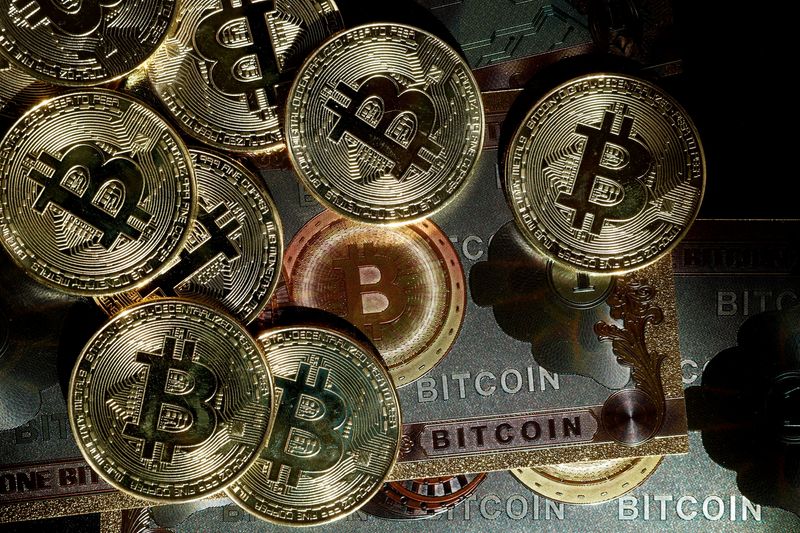News
Cryptocurrency “re-staking” platforms grow as traders chase higher returns

By Elizabeth Howcroft
LONDON (Reuters) – More than $18 billion worth of cryptocurrencies have been moved to a new type of platform that offers investors rewards in exchange for locking up their tokens, in a complex scheme that analysts say poses a risk to users and for the cryptocurrency market.
The growing popularity of so-called “re-staking” is the latest sign of risk-taking in cryptocurrency markets as prices rise and traders chase yield. Bitcoin, the largest cryptocurrency, is near all-time highs while Ether, the second largest, is up more than 60% this year.
At the center of the re-staking boom is Seattle-based start-up EigenLayer. The company, which raised $100 million from the crypto arm of US venture capital firm Andreessen Horowitz in February, has attracted $18.8 billion in cryptocurrencies to its platform, up from less than $400 million six months ago .
EigenLayer invented re-staking to expand a long-standing cryptographic practice called staking, its founder Sreeram Kannan told Reuters.
Blockchains are a kind of database, involving many computers in a network that monitor and confirm who owns which cryptocurrencies. To do this, owners of crypto tokens, such as Ether, allow their assets to be locked as part of the validation process. Holders lose immediate access to their tokens as long as they participate in staking, but in exchange they earn a return.
Some staking platforms also offer users newly created cryptocurrencies to represent the cryptocurrencies they have staked. Re-staking allows owners to take those new tokens and re-stake them with different blockchain-based programs and applications in hopes of higher returns.
The cryptocurrency world is divided over how risky re-staking is, with some industry insiders saying the practice is too nascent to know.
But others, including analysts, worry that if new tokens representing re-staking cryptocurrencies are used as collateral in the vast crypto lending markets, there could be endless cycles of lending based on a small number of underlying assets. That could destabilize broader cryptocurrency markets if everyone tries to exit at the same time, they say.
“When you have something that has collateral upon collateral, it’s not ideal, it adds a new element of risk that wasn’t there,” said Adam Morgan McCarthy, research analyst at crypto data provider Kaiko.
The attraction for investors is the yield: returns from staking on the Ethereum blockchain are typically between 3% and 5%, but analysts say returns could be higher for re-staking, as the investors can earn multiple returns at once.
Re-staking is the latest development in the risky world of decentralized finance, or DeFi, in which cryptocurrency holders invest in experimental schemes in the hope of generating large returns on their holdings without having to sell them.
The story continues
However, the EigenLayer platform has yet to pay out staking rewards directly to users, because the mechanism to do so has not been developed. Users join the platform in anticipation of future rewards or other freebies known as airdrops.
For now, EigenLayer has distributed its newly created token to people using the platform. Users hope that this token called “EIGEN” will be worth something in the future.
Kaiko’s Morgan McCarthy said the growth of re-staking platforms has been fueled by users seeking such launches, calling it “really, really speculative, this free money thing.”
“It’s very risky,” said David Duong, head of research at U.S. cryptocurrency exchange Coinbase, which offers staking but not re-staking.
“They’re doing it preemptively right now, (with the) expectation of being rewarded with something but they don’t know what,” Duong said.
ENTER EIGENLAYER
EigenLayer was launched last year by Sreeram Kannan, a former assistant professor at the University of Washington in Seattle and part of a team that launched the first student-designed micro-satellite in India, according to his academic website.
EigenLayer describes itself as a marketplace for validation services, connecting would-be stakers with applications that need staking tokens.
New re-staking platforms have emerged, including EtherFi, Renzo and Kelp DAO, which re-stake customer tokens on EigenLayer for them and generate new tokens to represent those re-staking assets. These tokens can be used elsewhere, for example as collateral in loans.
Kannan said the goal of his platform is to allow users to choose where to stake their tokens and help the growth of new blockchain services, not to increasingly incentivize cryptocurrency-backed loans.
“We have no official relationship with any of these players… This is an emerging phenomenon,” he said.
Coinbase’s Duong says re-staking could pose “hidden risks”: If re-staking tokens were used in crypto lending, there could be forced liquidations and increased volatility during market downturns, he wrote in a note.
The 2022 sell-off in cryptocurrency markets was exacerbated by high-risk lending, as crypto tokens used as collateral rapidly lost their value following the collapse of the Earth and Moon tokens.
Kannan distances EigenLayer from risks.
“The risk is not in the re-staking but rather in the lending protocols. The lending protocols are incorrectly pricing the risk,” he said.
Some experts are not concerned about re-staking, pointing out that the money made from re-staking protocols is tiny compared to the $2.5 trillion in net assets of the global cryptocurrency industry.
Regulators have long been concerned about losses in the cryptocurrency world spilling over into broader financial markets.
“For now, we see no significant risk of contagion from repositioning of issues in traditional financial markets,” said Andrew O’Neill, head of digital asset analysis at S&P Global Ratings.
However, the world of cryptocurrencies is becoming more and more connected to traditional finance and re-staking is gaining traction among institutional investors.
Zodia Custody, a division of Standard Chartered, has seen significant institutional interest in staking, but believes re-staking is a step too far because it is difficult to establish a “paper trail” of where assets go and how rewards are split, Chief Risk Officer Anoosh Arevshatian said.
Nomura’s crypto arm, Laser Digital, has partnered with Kelp DAO to reshare some of its funds, Kelp DAO said in an April blog post. Laser Digital did not respond to a Reuters request for comment.
Cryptocurrency-focused Swiss bank Sygnum said it stakes customers’ crypto assets and expects “a new ecosystem to emerge around re-staking.”
(Reporting by Elizabeth Howcroft; Editing by Tommy Reggiori Wilkes and Sharon Singleton)
News
Cryptocurrency Price August 1: Bitcoin Dips Below $65K; Solana, XRP Down Up To 8%

Major cryptocurrencies fell in Thursday trading following the Federal Reserve’s decision to keep its key interest rate unchanged. Overnight, the U.S. Federal Reserve kept its key interest rate at 5.25-5.5% for the eighth consecutive time, as expected, while also signaling the possibility of a rate cut at its next meeting in September. The unanimous decision by the Federal Open Market Committee reflects a continued wait-and-see approach as it monitors inflation trends.
CoinSwitch Markets Desk said: “Bitcoin has fallen below $65,000 after the US Federal Reserve announced it would keep interest rates unchanged. However, with markets now anticipating rate cuts at the next Federal Reserve meeting in September, the outlook for a Bitcoin rally by the end of the year has strengthened.”
Meanwhile, CoinDCX research team said: “The crypto market has plunged after the Fed decision. Tomorrow’s US unemployment rate announcement is expected to induce more volatility, with the ‘actual’ figure coming in higher than the ‘expected’ one, which is positive for cryptocurrencies.”
At 12:21 pm IST, Bitcoin (BTC) was down 3.2% at $64,285, while Ethereum was down nearly 4.5% at $3,313. Meanwhile, the global market cryptocurrency The market capitalization fell 3.6% to around $2.3 trillion in the last 24 hours.
“Bitcoin needs to clear its 200-day EMA at $64,510 to consolidate further. Otherwise, a retest of $62,000 could be in the cards,” said Vikram Subburaj, CEO of Giottus.
Altcoins and meme coins, such as BNB (3%), Solana (8%), XRP (5.7%), Dogecoin (5%), Cardano (4.6%), Avalanche (4.3%), Shiba Inu (3.8%), Polkadot (3.4%), and Chainlink (4%) also saw declines.
The volume of all stablecoins is now $71.64 billion, which is 92.19% of the total cryptocurrency market volume in 24 hours, according to data available on CoinMarketCap. Bitcoin’s dominance is currently 54.99%. BTC volume in the last 24 hours increased by 23.3% to $35.7 billion.
(Disclaimer: Recommendations, suggestions, opinions and views provided by experts are personal. They do not represent the views of the Economic Times)
(You can now subscribe to our ETMarkets WhatsApp Channel)
News
Altcoins WIF, BONK, RUNE, JUP Down 10% While Bitcoin Drops 4%

Altcoins dogwifhat, Bonk, THORChain, and Jupiter have suffered losses of more than 10%, while Bitcoin is down 4% in the last 24 hours.
After a period of relative calm yesterday, July 31, Bitcoin (BTC) price action has seen a drastic change as the cryptocurrency dropped by more than $3,500, bringing its value to $63,300. At the same time, altcoins mirrored this trend, with the total value of liquidated positions rising to nearly $225 million over the course of the day.
Initially, the week started on a positive note for Bitcoin, which reached its highest point since early June, hitting $70,000. However, this peak was short-lived, as it was quickly rejected, leading to a substantial decline, with Bitcoin falling below $65,500.
The cryptocurrency managed to regain some stability, trading comfortably at around $66,800. However, following a Press conference According to Federal Reserve Chairman Jerome Powell, the value of Bitcoin has fallen again to $64,300, down more than 3% in 24 hours.
BTC Price Chart 24 Hours | Source: crypto.news
The recession coincided with a relationship from the New York Times stating that Iran had called for retaliatory measures against Israel following the assassination of Hamas leader Ismail Haniyeh in Tehran, increasing the risk of further conflict in the region.
Meanwhile, on the economic front, the Federal Reserve decided to keep its benchmark interest rates in place, offering little information on a planned September rate cut. Powell also hinted that while no concrete decisions have been made on the September adjustment, there is growing consensus that a rate cut is likely.
Amid Bitcoin’s decline, altcoins have suffered even more significant losses. For example, dogwifhat (Wife) saw a 12.4% drop and (DISGUST) has suffered a 10% drop. Other altcoins such as THORChain (RUNE) also fell by 10%, while Jupiter (JUPITER) and the Ethereum naming service (ENS) decreased by 8% and 9% respectively.
Among the largest-cap cryptocurrencies, the biggest losers are Solana (SOL) with a decrease of 8%, (Exchange rate risk) down 6%, Cardano (ADA) down 4%, and both Ethereum (ETH) and Dogecoin (DOGE) recording a decrease of 4.4%.
Data from CoinGlass indicates that approximately 67,000 traders have been negatively impacted by this increased volatility. BTC positions have seen $61.85 million in liquidations, while ETH positions have faced $61 million. In total, the value of liquidated positions stands at $225.4 million at the time of writing.
News
Riot Platforms Sees 52% Drop in Bitcoin Production in Q2

Bitcoin mining firm Riot Platforms has released its second-quarter financial results, highlighting a decline in cryptocurrency mined due to the recent halving.
Colorado-based Bitcoin (BTC) mining company Riot platforms revealed its second quarter financial results, highlighting a significant reduction in mined cryptocurrencies attributed to the recent halving event that took place in early April.
The company reported total revenue of $70 million for the quarter ended July 31, a decline of 8.7% compared to the same period in 2023. Riot Platforms attributed the revenue decline primarily to a $9.7 million decrease in engineering revenue, which was partially mitigated by a $6 million increase in Bitcoin extraction income.
During the quarter, the company mined 844 BTC, representing a decline of over 50% from Q2 2023, citing the halving event and increasing network difficulty as major factors behind the decline. Riot Platforms reported a net loss of $84.4 million, or $0.32 per share, missing Zacks Research forecast a loss of $0.16 per share.
Halving increases competitive pressure
The Colorado-based firm said the average cost of mining one BTC in the second quarter, including energy credits, rose to $25,327, a remarkable 341% increase from $5,734 per BTC in the same quarter of 2023. Despite this significant increase in production costs, the firm remains optimistic about maintaining competitiveness through recent deals.
For example, following the Recent acquisition Cryptocurrency firm Block Mining, Riot has increased its distributed hash rate forecast from 31 EH/s to 36 EH/s by the end of 2024, while also increasing its 2025 forecast from 40 EH/s to 56 EH/s.
Riot Platforms Hashrate Growth Projections by 2027 | Source: Riot Platforms
Commenting on the company’s financials, Riot CEO Jason Les said that despite the halving, the mining company still managed to achieve “significant operational growth and execution of our long-term strategy.”
“Despite this reduction in production available to all Bitcoin miners, Riot reported $70 million in revenue for the quarter and maintained strong gross margins in our core Bitcoin mining business.”
Jason Les
Following its Q2 financial report, Riot Platforms shares fell 1.74% to $10.19, according to Google Finance data. Meanwhile, the American miner continues to chase Canadian rival Bitfarms, recently acquiring an additional 10.2 million BITF shares, increasing its stake in Bitfarms to 15.9%.
As previously reported by crypto.news, Riot was the first announced a $950 million takeover bid for Bitfarms in late May, arguing that Bitfarms’ founders were not acting in the best interests of all shareholders. They said their proposal was rejected by Bitfarms’ board without substantive engagement.
In response, Bitfarms She said that Riot’s offer “significantly understates” its growth prospects. Bitfarms subsequently implemented a shareholder rights plan, also known as a “poison pill,” to protect its strategic review process from hostile takeover attempts.
News
Aave Price Increases Following Whales Accumulation and V3.1 Launch

Decentralized finance protocol Aave is seeing a significant spike in whale activity as the market looks to recover from the recent crash that pushed most altcoins into key support areas earlier this week.
July 31, Lookonchain shared details indicating that the whales had aggressively accumulated Aave (AAVE) over the past two days. According to the data, whales have withdrawn over 58,848 AAVE worth $6.47 million from exchanges during this period.
In one instance, whale address 0x9af4 withdrew 11,185 AAVE worth $1.23 million from Binance. Meanwhile, another address moved 21,619 AAVE worth over $2.38 million from the exchange and deposited the tokens into Aave.
These withdrawals follow a previous transfer of 26,044 AAVE from whale address 0xd7c5, amounting to over $2.83 million withdrawn from Binance.
AAVE price has surged over 7% in the past 24 hours amid buy-side pressure from these whales. The DeFi token is currently trading around $111 after jumping over 18% in the past week.
Recently, the price of AAVE increased by over 8% after Aave founder Marc Zeller announced a proposed fee change aimed at adopting a buyback program for AAVE tokens.
Aave v3.1 is available
The total value locked in the Aave protocol currently stands at around $22 billion. According to DeFiLlamaApproximately $19.9 billion is on Aave V3, while the V2 chain still holds approximately $1.9 billion in TVL and V1 approximately $14.6 million.
Aave Labs announced Previously, Aave V3.1 was made available on all networks with active Aave V3 instances.
V3.1 features improvements that are intended to improve the overall security of the DeFi protocol. The Aave DAO governance has approved the v3.1 improvements, which also include operational efficiency and usability for the network.
Meanwhile, Aave Labs recently outlined a ambitious roadmap for the projectwith a 2030 vision for Aave V4, among other developments.
-

 Regulation11 months ago
Regulation11 months agoRipple CTO and Cardano founder clash over XRP’s regulatory challenges ⋆ ZyCrypto
-

 Regulation10 months ago
Regulation10 months agoNancy Pelosi Considers Supporting Republican Crypto Bill FIT21 – London Business News
-

 Videos11 months ago
Videos11 months agoCryptocurrency News: Bitcoin, ETH ETF, AI Crypto Rally, AKT, TON & MORE!!
-

 Regulation11 months ago
Regulation11 months agoBitcoin’s future is ‘bleak’ and ripe for regulation, says lead developer
-

 News8 months ago
News8 months agoAave Price Increases Following Whales Accumulation and V3.1 Launch
-

 Regulation8 months ago
Regulation8 months agoSouth Korea Imposes New ‘Monitoring’ Fees on Cryptocurrency Exchanges
-

 Regulation8 months ago
Regulation8 months agoA Blank Sheet for Cryptocurrencies: Kamala Harris’ Regulatory Opportunity
-

 Regulation8 months ago
Regulation8 months agoCryptocurrency Regulations in Slovenia 2024
-

 News11 months ago
News11 months agoThe trader earned $46 million with PEPE after reaching a new ATH
-

 Regulation10 months ago
Regulation10 months agoCrypto needs regulation to thrive: Tyler Cowen
-

 Blockchain11 months ago
Blockchain11 months agoSolana ranks the fastest blockchain in the world, surpassing Ethereum, Polygon ⋆ ZyCrypto
-

 Blockchain11 months ago
Blockchain11 months agoSolana Surpasses Ethereum and Polygon as the Fastest Blockchain ⋆ ZyCrypto













